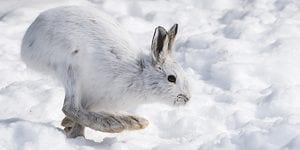This essay opens up with the declaration that there is a 10-year cycle in the population of snowshoe hares. The experiment conducted was to determine if that 10-year cycle could be effected by manipulation of predation and prevalence of food in the populated region.
To conduct this experiment, the authors manipulated the environment in several ways during the cycle that was taking place from 1987 to 1994. After partitioning the region into nine 1km-square blocks. In two blocks, fertilizer was spread to promote the growth of vegetation and provide a more ample source of food to the hares. In two blocks, food was made more abundant directly. One block was fenced off to prevent mammalian predation. One block both was fenced off to prevent mammalian predation, as well as had supplemental food introduced. The last three blocks were used as controls. It is important to note that in the two regions with fences, the fences were permeable to snowshoe hares, and that predation from avian predators was not restricted.
To avoid this summary becoming too long, I’m going to be brief in getting to the results. The fertilizer had a very slim effect on the overall trend of the growth, peak, and decline of the hare population. Supplemental food had a positive effect during the decline, increasing hare density anywhere from 1.5 to 6-fold during the decline. Predator exclosure had almost no effect until late decline when it increased hare density by up a similar 1.4 to 6-fold. Supplemental food and mammalian predator exclosure had the greatest effect; from the peak onward, it increased hare density by up to 11-fold.
Even with the two most successful manipulations in place, the decline in population was still incredibly pronounced. Several factors could contribute to this, for example, the predator exclosures were permeable by the hares, meaning they could leave the exclosures and be eaten by the predators. This does not explain why the hares in the block with additional food as well as predator exclusion would have left. Additionally, the exclosures were not protected from avian predators, which may have had a profound undocumented effect on hare population, particularly when not in competition for food with land-based predators.
The results of this show that there is at least one more factor other than food and mammalian predation causing the 10-year cycle in snowshoe hare population. A follow up study restricting both land-based and avian predators from entering a habitat with additional food would help to determine the effect of avian predation. Another experiment excluding mammalian predators with an electric fence permeable to the hares around a region with supplemental food where additionally the behaviors of the hares were tracked when they left the exclosure may help determine what led them to expose themselves to predation.
